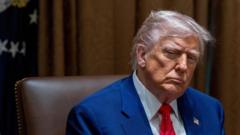In a week filled with significant developments, President Donald Trump has made waves with his proposed massive tariff plan aimed at reshaping global trade dynamics and impacting America's trade relations with allies. However, this strategy is currently on hold, as Trump has paused higher tariffs for 90 days, particularly during his ongoing trade conflict with China. This raises the question: is Trump’s administration any closer to achieving its trade goals? Let’s explore five critical objectives Trump has set and their current status.
1) **Securing Better Trade Deals**
Trump has long claimed that the U.S. has been taken advantage of in trade for years by both allies and adversaries. His recent tariff proposals, which included a baseline tariff of 10% on virtually all imports, generated significant responses from the international community. According to Treasury Secretary Scott Bessent, more than 75 world leaders have approached Trump seeking negotiations or trade concessions. The administration is currently engaged in talks with nations like South Korea and Japan. This pause on tariffs offers a window of opportunity, as countries have 90 days to reach agreements. Overall, the ongoing discussions suggest a potential to attain concessions during this period.
2) **Revitalizing American Industry**
For Trump, tariffs are a key mechanism to bolster U.S. manufacturing and bring jobs back home. However, the recent uncertainty around tariff consistency complicates this objective. Businesses need a stable environment to make significant investments and shift production back to the U.S. The fluctuating nature of recent tariff announcements makes it challenging for companies to commit to domestic expansion, which could result in delayed decisions as they wait for clarity on future tariff implications.
3) **Confronting China**
While Trump has expressed respect for China, he places blame on the nation for various trade-related issues. Recent insights from White House officials indicate that the administration aims to impose significant economic pressure on China, identified as a primary source of trade disadvantages for the U.S. However, aligning interests while navigating a confrontation with China poses substantial risks. This strategy could alienate essential allies needed for support in any potential conflict.
4) **Increasing Revenue**
Trump has often highlighted the financial benefits of tariffs, projecting that they could add considerably to federal revenue. A study estimated that universal tariffs could generate $2 trillion over the next decade, potentially aiding in reducing the budget deficit. As long as Trump maintains his tariff structure, there is a viable path for wealth generation. However, this revenue stream might dwindle if domestic production replaces imports.
5) **Lowering Consumer Prices**
Trump has assured that enhancing U.S. production would lead to lower consumer prices. Contrary to this claim, experts suggest the opposite: the introduction of tariffs could result in increased costs for American households. Studies indicate a $1,253 increase in expenses per household in the initial year of a universal tariff. Such price hikes may weigh heavily on lower-income families, undermining Trump’s effort to deliver economic relief through trade policies, a crucial factor as he looks toward future electoral success.
As developments unfold in Trump’s trade narrative, the interim suspension of higher tariffs creates both opportunities and challenges for his administration’s long-term objectives.
1) **Securing Better Trade Deals**
Trump has long claimed that the U.S. has been taken advantage of in trade for years by both allies and adversaries. His recent tariff proposals, which included a baseline tariff of 10% on virtually all imports, generated significant responses from the international community. According to Treasury Secretary Scott Bessent, more than 75 world leaders have approached Trump seeking negotiations or trade concessions. The administration is currently engaged in talks with nations like South Korea and Japan. This pause on tariffs offers a window of opportunity, as countries have 90 days to reach agreements. Overall, the ongoing discussions suggest a potential to attain concessions during this period.
2) **Revitalizing American Industry**
For Trump, tariffs are a key mechanism to bolster U.S. manufacturing and bring jobs back home. However, the recent uncertainty around tariff consistency complicates this objective. Businesses need a stable environment to make significant investments and shift production back to the U.S. The fluctuating nature of recent tariff announcements makes it challenging for companies to commit to domestic expansion, which could result in delayed decisions as they wait for clarity on future tariff implications.
3) **Confronting China**
While Trump has expressed respect for China, he places blame on the nation for various trade-related issues. Recent insights from White House officials indicate that the administration aims to impose significant economic pressure on China, identified as a primary source of trade disadvantages for the U.S. However, aligning interests while navigating a confrontation with China poses substantial risks. This strategy could alienate essential allies needed for support in any potential conflict.
4) **Increasing Revenue**
Trump has often highlighted the financial benefits of tariffs, projecting that they could add considerably to federal revenue. A study estimated that universal tariffs could generate $2 trillion over the next decade, potentially aiding in reducing the budget deficit. As long as Trump maintains his tariff structure, there is a viable path for wealth generation. However, this revenue stream might dwindle if domestic production replaces imports.
5) **Lowering Consumer Prices**
Trump has assured that enhancing U.S. production would lead to lower consumer prices. Contrary to this claim, experts suggest the opposite: the introduction of tariffs could result in increased costs for American households. Studies indicate a $1,253 increase in expenses per household in the initial year of a universal tariff. Such price hikes may weigh heavily on lower-income families, undermining Trump’s effort to deliver economic relief through trade policies, a crucial factor as he looks toward future electoral success.
As developments unfold in Trump’s trade narrative, the interim suspension of higher tariffs creates both opportunities and challenges for his administration’s long-term objectives.





















